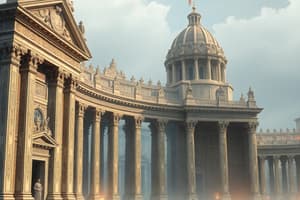Podcast
Questions and Answers
What is one harmful consequence of Roman expansion related to societal changes?
What is one harmful consequence of Roman expansion related to societal changes?
- Decrease in slave population
- Increase in wealth distribution
- Rise in urban poor (correct)
- Rise in the number of small landowners
The Gracchii brothers successfully implemented all of their proposed reforms.
The Gracchii brothers successfully implemented all of their proposed reforms.
False (B)
Who was responsible for transforming the military into a client army?
Who was responsible for transforming the military into a client army?
Marius
Tiberius Gracchus bypassed the _____ to pass his land reform laws.
Tiberius Gracchus bypassed the _____ to pass his land reform laws.
Match the following figures with their notable actions or characteristics:
Match the following figures with their notable actions or characteristics:
Which role is responsible for commanding the army and seeking the approval of the gods?
Which role is responsible for commanding the army and seeking the approval of the gods?
The Roman Senate had direct legislative power to enforce laws.
The Roman Senate had direct legislative power to enforce laws.
What is the term used for the path of honors that one must follow to rise to high power in Roman government?
What is the term used for the path of honors that one must follow to rise to high power in Roman government?
The __________ was created to protect the interests of the plebeians and is considered sacrosanct.
The __________ was created to protect the interests of the plebeians and is considered sacrosanct.
Match the following Roman magistrates with their primary roles:
Match the following Roman magistrates with their primary roles:
What describes the Roman government's combination of leadership forms?
What describes the Roman government's combination of leadership forms?
The Plebian Assembly elects consuls and quaestors.
The Plebian Assembly elects consuls and quaestors.
What is the maximum duration for which a dictator could be appointed in Rome during emergencies?
What is the maximum duration for which a dictator could be appointed in Rome during emergencies?
Flashcards
Prorogation
Prorogation
The practice of extending the term of a magistrate beyond the standard duration, usually for urgent situations. It's like giving a temporary extension when your homework is due.
Latifundia
Latifundia
Large agricultural estates owned by wealthy Romans that were often worked by slaves. These estates caused social problems like landlessness and poverty for small farmers.
Populares
Populares
Roman politicians who favored the interests of the common people, the "people's party". They often advocated for social reforms and opposed the power of the Senate.
Optimates
Optimates
Signup and view all the flashcards
Marius
Marius
Signup and view all the flashcards
What was the Roman Constitution like?
What was the Roman Constitution like?
Signup and view all the flashcards
Describe the Roman social order.
Describe the Roman social order.
Signup and view all the flashcards
Who were the magistrates in the Roman government?
Who were the magistrates in the Roman government?
Signup and view all the flashcards
What were the powers of the Consuls?
What were the powers of the Consuls?
Signup and view all the flashcards
What was the role of the Senate in the Roman government?
What was the role of the Senate in the Roman government?
Signup and view all the flashcards
How did the Roman people participate in government?
How did the Roman people participate in government?
Signup and view all the flashcards
What was the purpose of the Tribune of the Plebs?
What was the purpose of the Tribune of the Plebs?
Signup and view all the flashcards
What was the Cursus Honorum?
What was the Cursus Honorum?
Signup and view all the flashcards
Study Notes
Roman Constitution (Based on Polybius)
- Not a written document; developed over time through unwritten guidelines and principles.
- Social orders divided into classes: men over women, free over slaves, patricians over plebeians.
- Government structure comprised of magistrates and assemblies. Magistrates held one-year terms, and there were two of each magistrate type.
- Combined elements of monarchy, aristocracy, and democracy.
Monarchic Elements (Consuls)
- Consuls were the highest magistrates, commanding armies in war and governing cities in peace.
- Held two powers: Imperium (command of the army) and Auspicium (seeking approval from the gods).
- Censors held 18-month terms, conducted censuses, and were among the most prestigious offices.
- Praetors supported consuls.
- Aediles managed public buildings, festivals, and order.
- Quaestors oversaw the treasury.
- Tribunes of the Plebians were created to protect plebeian interests and were considered sacrosanct.
- Dictators held extraordinary powers for six months and were appointed by the Senate during emergencies.
Oligarchic Elements (Senate)
- Senate was an assembly of wealthy citizens.
- Senate acted as an advisory board through senatus consulta.
- Senate controlled finances and foreign policy.
- Consuls appointed senators.
Democratic Elements (Popular Assemblies)
- Popular assemblies, or assemblies of ordinary citizens represented the democratic elements.
- Assemblies held power to check consuls and the Senate through electing officers and enacting laws.
Governing Branches Checking Each Other
- Consuls had veto power over each other and could not bring armies into the city.
- Censors oversaw and regulated membership and actions of senators.
- Assemblies approved officers, laws, and checked actions of magistrates.
- Tribunes of the Plebians possessed a veto power against laws that harmed the common people.
Studying That Suits You
Use AI to generate personalized quizzes and flashcards to suit your learning preferences.




